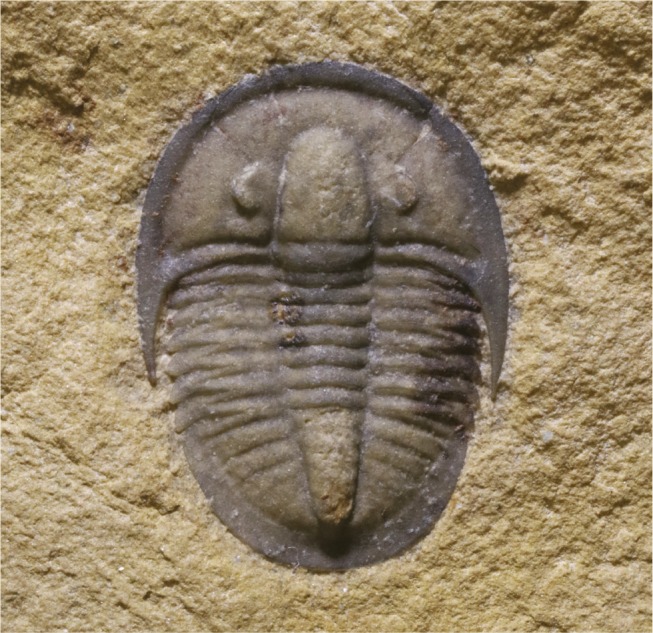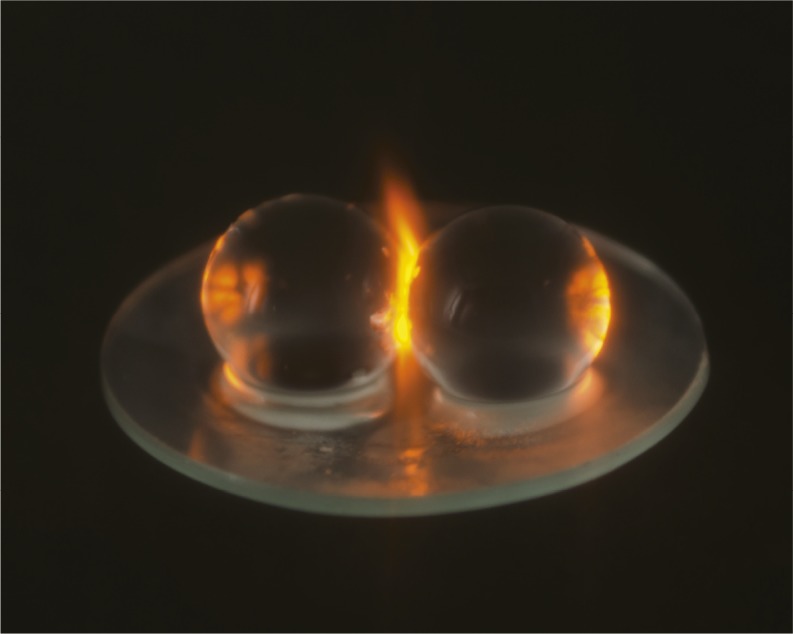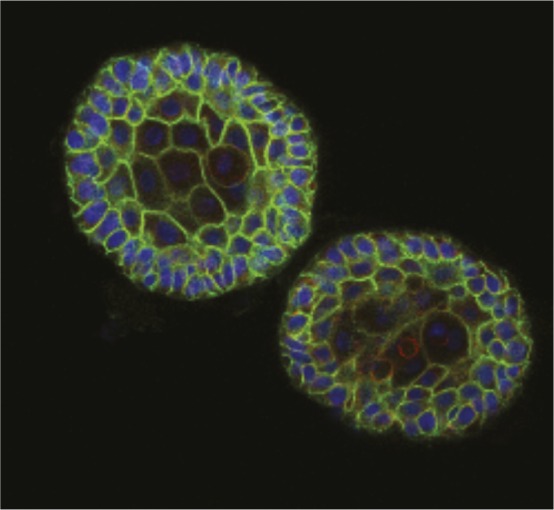Trilobites and end of Cambrian explosion

Cambrian trilobite fossil from Utah.
The sudden appearance of numerous diverse animals more than 500 million years ago, known as the Cambrian explosion, is one of the most significant events in the history of life. However, the tempo and duration of this evolutionary milestone remains vigorously debated. John Paterson et al. (pp. 4394–4399) analyzed more than 100 anatomical traits of more than 100 species of trilobites, the most diverse and abundant Cambrian animals, spanning approximately 520–485 million years ago, to estimate the animals’ evolutionary rates. Multiple statistical models revealed uniform evolutionary rates throughout the entire time interval. The results suggest that the Cambrian explosion ended much earlier than widely assumed; by around 520 million years ago, the evolutionary rates that presumably characterized the Cambrian explosion had already slowed to levels typical of the ensuing eon. The authors further estimated that all trilobites diverged from a common ancestor less than 540 million years ago, suggesting that trilobites did not have a prolonged history prior to their appearance in the fossil record. The latter finding suggests that modern animal groups first evolved, diversified, and completely reengineered the marine ecosystem, possibly in the brief span of 20 million years, according to the authors. — B.D.
New parents and STEM careers
Women are underrepresented in science, technology, engineering, and medicine (STEM) careers, and parenthood is thought to contribute to the gender gap. Erin Cech and Mary Blair-Loy (pp. 4182–4187) analyzed nationally representative longitudinal survey data from STEM professionals in the United States collected between 2003 and 2010 by the National Science Foundation. The authors found that within 7 years of the birth or adoption of their first child, 43% of women and 23% of men left full-time STEM careers. Compared with new fathers, new mothers were more likely to switch to part-time work or leave the workforce. Compared with childless peers who transitioned out of STEM careers, new parents were more likely to attribute the transition to family-related reasons. Once parents left the STEM workforce, they were unlikely to return by the time children were old enough to attend school. Although the finding held true across STEM disciplines, new parents in the life sciences were more likely than those in engineering to leave the workforce. The results suggest that parenthood contributes to gender imbalance in STEM employment as well as the need to find ways to help new parents balance careers with parenting. — M.S.
How grapes produce sparks in microwave ovens

Plasma formed between a pair of hydrogel beads irradiated in a microwave oven.
Irradiating grape halves in a household microwave oven produces plasma. However, a physical explanation of this phenomenon is lacking. Hamza Khattak et al. (pp. 4000–4005) combined thermal imaging with computer simulations of electromagnetic fields to elucidate the physics underlying the production of sparks from microwave-irradiated grapes. Typical demonstrations use grape halves, connected by a strip of skin, but the authors found that whole grapes and skinless hydrogel beads are similarly capable of producing plasma, as long as there is physical contact. Thermal imaging and computer simulations of isolated irradiated beads revealed that temperatures and energy densities were maximal in the center, indicating the existence of morphology-dependent microwave resonances. When two beads were in contact, a bonding-like interaction between the resonant modes of each bead led to the formation of a hot spot at the point of contact, much smaller than the irradiating wavelength, with substantially greater temperature and energy density than in the isolated beads. The absorption of microwaves by water serves to suppress internal modes and allow hot spots to form over a range of bead sizes. According to the authors, such a system could be useful for experimental research in nanophotonics. — B.D.
Genetic variation and adaptation in Africa
Little is known about the demographics and movement patterns in Africa between the time modern humans developed, around 300,000 years ago, and the time groups began leaving Africa, 80,000–40,000 years ago. Laura Scheinfeldt, Sameer Soi, et al. (pp. 4166–4175) analyzed variation in genetic data from 840 Africans from across the continent and across multiple linguistic groups and societal subsistence lifestyles, including hunter-gatherer societies. Language groups were correlated with genetic diversity, as were geography and subsistence lifestyle. For example, the results suggested that four hunter-gatherer groups whose language contains clicks, including the Hadza, Sandawe from Tanzania, and Dahalo from Kenya, and the Sabue from Ethiopia, whose language is unclassified, displayed genetic similarity to each other, despite geographic separation. Most other hunter-gatherer societies were genetically similar to neighboring agricultural or pastoral societies. Next, the authors examined the genes most likely to be associated with genetic variation among African groups, and found that many genes were involved in immune function and adaptation to diverse climates and diets. These included genes associated with malaria resistance and carbohydrate and lipid metabolism. According to the authors, although selective pressures are widespread across Africa, genetic variation among Africans suggests that the genes that enable response to selective pressures may vary across populations. — P.G.
Bladder organoids for cancer research

Mouse bladder organoids stained for DNA (blue), CD44 (green), and actin (red).
Bladder cancer is a relatively common cancer, and treatment has improved only modestly in the past 30 years, partly due to the lack of model systems for studying the bladder epithelium, or urothelium. Jasper Mullenders et al. (pp. 4567–4574) developed a culture system for urothelial organoids from both mice and humans. The organoids are small collections of bladder-specific cell types that are spatially organized in the same way as in a functional bladder and recapitulate aspects of bladder function. The authors generated mouse bladder organoids from extracted bladder cells and genetically edited them using CRISPR/Cas9 technology. Human bladder organoids were generated from surgically removed bladders and bladder tumor biopsies and maintained for longer than 1 year in culture. The authors created a biobank of bladder cancer organoids derived from 53 bladder cancer patients. Histological analysis identified both subtypes of bladder cancer—luminal and basal—among the organoids, and an abundance of cells positive for a marker of tumor initiation. According to the authors, bladder organoids could be used for drug screening, facilitating the development of bladder cancer therapeutics. — B.D.
How Southern Ocean phytoplankton thrive in low light, temperature, and iron
Photosynthetic marine organisms known as phytoplankton convert surface ocean CO2 into organic carbon, some of which sinks, thus transferring atmospheric CO2 into the ocean’s interior. In the icy waters of the Southern Ocean (SO), phytoplankton growth and productivity are restricted by cold temperatures, low light, and deficits in iron, a trace element required for carbon fixation. Robert Strzepek et al. (pp. 4388–4393) describe experiments aimed at determining whether resident SO phytoplankton have acquired adaptations that enhance productivity in extreme conditions. Using cultures of the bloom-forming SO phytoplankton Eucampia antarctica, Proboscia inermis, and Phaeocystis antarctica, the authors demonstrate that all three species exhibit higher photosynthetic rates than expected in cold, low-iron waters under low light intensities, when compared with similar temperate species. The authors suggest that the species’ large light-harvesting antennae—among the largest observed in marine phytoplankton—represent an adaptation that confers enhanced low light energy transfer in polar waters. The findings indicate that SO phytoplankton have evolved mechanisms to optimize use of multiple limiting resources in their environment. According to the authors, the findings could inform future polar studies aimed at determining the impacts of altered ocean conditions driven by global climate change. — T.J.


